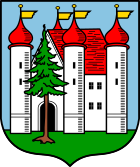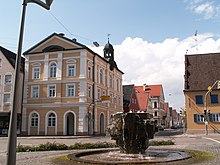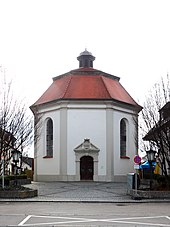Thannhausen (Swabia)
| coat of arms | Germany map | |
|---|---|---|

|
Coordinates: 48 ° 17 ' N , 10 ° 28' E |
|
| Basic data | ||
| State : | Bavaria | |
| Administrative region : | Swabia | |
| County : | Gunzburg | |
| Management Community : | Thannhausen | |
| Height : | 499 m above sea level NHN | |
| Area : | 20.03 km 2 | |
| Residents: | 6250 (Dec. 31, 2019) | |
| Population density : | 312 inhabitants per km 2 | |
| Postal code : | 86470 | |
| Area code : | 08281 | |
| License plate : | GZ, KRU | |
| Community key : | 09 7 74 185 | |
| City structure: | 3 parts of the community | |
City administration address : |
Edmund-Zimmermann-Strasse 3 86470 Thannhausen |
|
| Website : | ||
| Mayor : | Alois Held ( CSU ) | |
| Location of the city of Thannhausen in the district of Günzburg | ||
Thannhausen is a town in the Swabian district of Günzburg and the seat of the Thannhausen administrative community .
geography
The city is located on the eastern range of hills of 500 m above sea level. d. M. lying Mindeltals between Augsburg , Ulm and Memmingen . Located on the western edge of the Augsburg-Westliche Wälder nature park , the 60 m high valley slope offers an interesting view of the city and Mindeltal.
Thannhausen is located in the Donau-Iller region .
The parish village of Burg , the main town of Thannhausen and the village of Nettershausen are parts of the parish and at the same time districts .
history
From AD 400
The first settlement in the current urban area goes back to around 400 AD.
In 1109 a noble family "von Taginhusen" was mentioned. In 1293 Thannhausen was granted market rights . In 1348 the bishopric of Augsburg and Burgau was granted feudal rights over Thannhausen. In 1569 the Augsburg patrician Baumgartner and the barons of Hohenschwangau rule and spell Thannhausen. Afterwards there were frequent changes of ownership. The Leonhardi Chapel was built around 1600. In 1665 the Counts of Sinzheim received the imperial fief over Thannhausen as a county , which was later transferred to the Counts of Stadion as a county. In 1673 the former courthouse was completed.
In 1718 the Counts von Stadion expelled all of Thannhausen's living Jews (see below). In 1746 the parish church Maria Himmelfahrt was built. Christoph von Schmid worked in Thannhausen from 1796 to 1816.
After 1800

With the Rhine Confederation Act in 1806, the place became part of the Kingdom of Bavaria . With the parish edict of 1818, today's parish was established as a self-governing body. The count's rulership of the Counts of Stadion was repealed in 1833. In 1873 the Stadlerstift was built, today a retirement home. The historic town hall was built between 1876 and 1877. In 1894, Thannhausen became the end of a railway line from Dinkelscherben , which was closed in 2001. The Mindelhalle was built in 1926.
After 1945
After the end of the Second World War, building activity began. 1953 Thannhausen received city rights . In 1965 the state secondary school was built , and in 1966 the Christ Church for Protestant believers was built. In 1976 the construction of the middle school was completed.
Before the municipal reform of the 1970s , Thannhausen belonged to the Krumbach district . In June 1972 this was dissolved, Thannhausen came to the district of Günzburg. In 1977 the municipality of Burg was incorporated with its municipality of Nettershausen. In 1981 the Thannhausen administrative community was formed. In 2011 the new administrative building of the Thannhausen administrative community was completed.
In 2007 the B 300 bypass was inaugurated, which had previously run through the town.
Thannhausen Jewish community
It is believed that Jews settled in Thannhausen either around 1400 or at the beginning of the 16th century . From the 15th to the 18th century there was at times a large Jewish community with around 300 people. Jews were expelled during the Thirty Years' War . There is evidence that there was a Jewish print shop in Thannhausen that printed a prayer book (1590–1592).
The Jews were not allowed to bury their dead in the village, but had to transport them to Kriegshaber for burial at night . It was not until 1567 that the Jews were allowed to set up their own cemetery, which was located on the road through the forest to Ziemetshausen in the “Jewish burial” corridor. The cemetery was occupied until 1718, gravestones have not been preserved.
In the second half of the 17th century, Jewish families could move in again. Graf Stadion took over control of Thannhausen in 1708 and at that time had 20 Jewish families. However, the Countess von Stadion disliked the presence of Jews in Thannhausen, which led to Count von Stadion approaching the emperor and requesting their expulsion. In August 1718 all Jews were expelled. The synagogue and the Jewish school building were demolished in 1719 and the stadium chapel that exists today was built in its place between 1720 and 1722. The name “Judenkapelle” from this building has been preserved to this day. The street name “Judengasse” also testifies to the historical presence of Jews in the village. It is located not far from the stadium chapel.
The local researcher J. Kahn found in his study of Jews in Thannhausen from the 1920s that no one lived there anymore. Only the name Thannhauser (also Dannhauser) reminds of the descendants of Jews originally settled in Thannhausen.
Population development
- 1961: 4055 inhabitants
- 1970: 4667 inhabitants
- 1987: 4825 inhabitants
- 1991: 5603 inhabitants
- 1995: 6303 inhabitants
- 2000: 6252 inhabitants
- 2005: 6168 inhabitants
- 2010: 5929 inhabitants
- 2015: 6,095 inhabitants
Between 1988 and 2018, the city grew from 4,946 to 6,277 by 1,331 inhabitants or 26.9%.
politics
City Councilor and Mayor
The city council has 20 members. In the past local elections, the seats were distributed among the individual lists as follows:
| Distribution of seats in local elections | 2002 | 2008 | 2014 | 2020 |
|---|---|---|---|---|
| CSU | 8th | 8th | 7th | 7th |
| SPD | 6th | 4th | 4th | 2 |
| Green | - | - | 2 | 4th |
| Free voters | 6th | 8th | 5 | 5 |
| List white | - | - | 2 | - |
| Young Union | - | - | - | 2 |
Alois Held (CSU) has been mayor since May 1, 2020; of three applicants, he reached the runoff election on March 15, 2020 with 46.7%, in which he was elected on March 29, 2020 with 69.7%.
Mayor was Johannes Schropp (CSU) from 1994 to April 30, 2008 and Georg Schwarz (CSU / FW) from May 1, 2008 to April 30, 2020. Schwarz (* 1958) was previously mayor of Neuburg an der Kammel ; in the 2014 local elections he was confirmed in office with a turnout of 57.9% with 77.6% of the valid votes.
coat of arms
Blazon : "In blue on green sign foot a rotwalmbedachtes perspective posed Silver Castle (House) with black circular portal, four black Fentsern (2/2) and four rotzwiebelbedachten silver Eckrundtürmen with pole, two each black windows, right rear, almost hidden by the building sullied, each with a golden weather vane waving to the left, a green, rooted fir tree in front of the gate. ”- The coat of arms contains a castle-like house and a fir tree - a talking coat of arms for the place name“ Thannhausen ”.
Town twinning
-
 Since 1981 there has been a partnership with the French municipality of Mortain in the southern department of Manche in Normandy . A large granite block, which was artistically included in the design of the Thannhauser Mortainplatz, reminds of this friendship.
Since 1981 there has been a partnership with the French municipality of Mortain in the southern department of Manche in Normandy . A large granite block, which was artistically included in the design of the Thannhauser Mortainplatz, reminds of this friendship.
Culture and sights
Architectural monuments
There are many listed, historical monuments in Thannhausen, especially in Bahnhof-, Christoph-von-Schmid- and Edmund-Zimmermann-Straße.
Numerous fountains by the sculptor Georg Brenninger (two different pigeon fountains, the Margaretenbrünnele, a muse fountain and a fountain called Petit Village) are located in exposed town squares.
Soil monuments
See: List of soil monuments in Thannhausen (Swabia)
Economy and Infrastructure
Thannhausen's economy is dominated by medium-sized and craft companies. The two largest medium-sized companies include Fleischwerke Zimmermann and Postbräu Thannhausen .
Companies
- Deikra-Futter GmbH
- Fleshwerks Zimmermann, who for 1989 Ehrmann AG belongs
- Leitenmeier Lorenz Straßen- und Tiefbau GmbH asphalt mixing plant
- Albert Mühlschlegel GmbH & Co. KG
- Postbräu Thannhausen Theodor Schreiegg GmbH & Co.
- Raiffeisenbank Thannhausen
- Höfle and Wohlrab Bau GmbH (HBW)
Public facilities
Thannhausen outdoor swimming pool, Thannhausen indoor swimming pool, Thannhausen public library, Kreisaltenheim, Franz-Xaver-Stadler'sche Poor and Sick Foundation (nursing home) expanded in 2006/2007.
Furthermore, there is a privately operated wakeboard facility in the Mindeltal, to the west of Thannhausen .
Museums
Thannhausen local history museum
education
- Anton Höfer Primary School
- Fritz Kieninger Middle School
- Christoph-von-Schmid-Realschule
- School camp of the city of Augsburg in Thannhausen
traffic
The municipal area is crossed by the federal highway 300 in an east-west direction . State Road 2025 runs from north to south .
Personalities
sons and daughters of the town
- Albert Höfer (1802–1857), pastor and hymn composer
- Wilhelm Bauberger (1809–1883), doctor and writer
- Franz Xaver Frey (1928–1987) born in the district of Nettershausen, lawyer, politician and district administrator
- Ralf Gollmitzer (1965–2011), musician, singer, composer, lyricist and arranger
Personalities who have worked on site
- Christoph von Schmid (1768–1854), Roman Catholic priest and writer
Web links
- Official website of the city of Thannhausen
- Entry on the coat of arms of Thannhausen (Swabia) in the database of the House of Bavarian History
Individual evidence
- ↑ "Data 2" sheet, Statistical Report A1200C 202041 Population of the municipalities, districts and administrative districts 1st quarter 2020 (population based on the 2011 census) ( help ).
- ^ Community Thannhausen in the local database of the Bavarian State Library Online . Bavarian State Library, accessed on August 28, 2019.
- ↑ a b c Thannhauser Gesichte in short form , on thannhausen.de. Retrieved August 21, 2018
- ↑ a b c Federal Statistical Office (ed.): Historical municipality directory for the Federal Republic of Germany. Name, border and key number changes in municipalities, counties and administrative districts from May 27, 1970 to December 31, 1982 . W. Kohlhammer, Stuttgart / Mainz 1983, ISBN 3-17-003263-1 , p. 774 .
- ↑ a b Jewish Bavaria: Die Juden von Thannhausen , on hagalil.com, accessed on January 16, 2016
- ↑ Stephen G. Burnett: 2016xt = classicsfacpub The Regulation of Hebrew Printing in Germany, 1555-1630: Confessional Politicsand and the Limits of Jewish Toleration ( page no longer available , search in web archives ) Info: The link was automatically marked as defective. Please check the link according to the instructions and then remove this notice. (English), from digitalscommuns.unl.edu, accessed on January 14, 2016
- ↑ Mansor , on alemannia-judaica.de, accessed on January 10, 2016
- ↑ a b J. Kahn: The Jews in Thannhausen , on alemannia-judaica.de. Retrieved January 10, 2015
- ↑ Jewish cemeteries in Bavaria , on uni-heidelberg, accessed on January 14, 2016
- ^ Thannhausen (district of Günzburg) Jewish history / synagogue on alemannia-judaica.de, accessed on January 10, 2014
- ↑ Brunnen , on georg-brenninger.de, accessed on January 10, 2016














